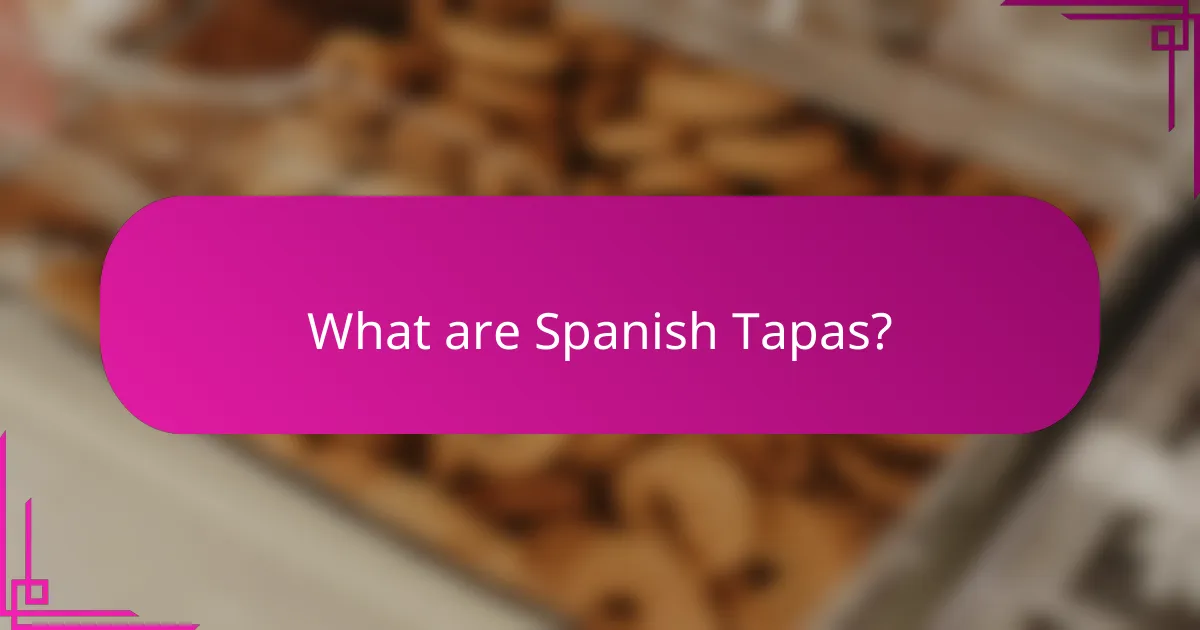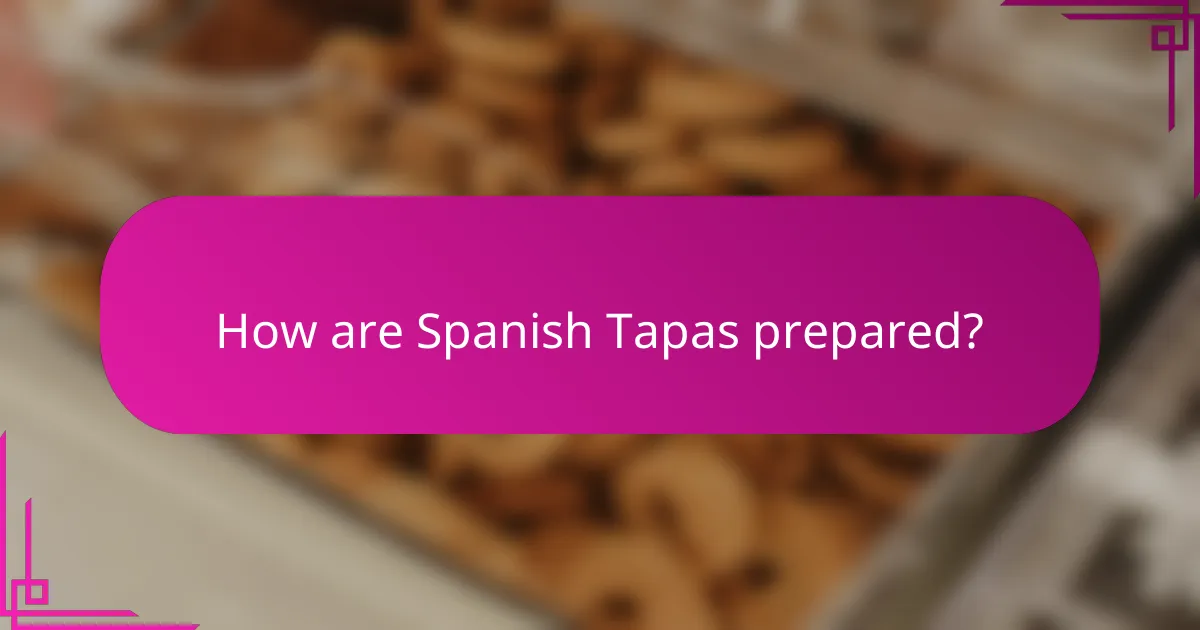Spanish tapas are small dishes that serve as appetizers or snacks, originating from Spain and commonly enjoyed with drinks. This culinary tradition, which dates back to the 13th century, promotes socializing and sharing among diners, with each region in Spain offering unique specialties. Tapas can be prepared using various techniques such as frying, grilling, and marinating, featuring ingredients like vegetables, meats, seafood, and cheeses, often seasoned with herbs and spices. The article also explores ideal pairing suggestions, highlighting wines, beers, and side dishes that enhance the tapas dining experience.

What are Spanish Tapas?
Spanish tapas are small dishes served as appetizers or snacks. They originate from Spain and are often enjoyed with drinks. Tapas can include a variety of foods, such as olives, cheeses, meats, and seafood. The tradition of tapas dates back to the 13th century. They encourage socializing and sharing among diners. Many regions in Spain have their own unique tapas specialties. Tapas can be served hot or cold, depending on the dish. The concept has gained popularity worldwide, influencing dining culture in many countries.
How did Spanish Tapas originate?
Spanish tapas originated in Spain as small plates of food served alongside drinks. The tradition dates back to the 13th century during the reign of King Alfonso X. He promoted the idea of serving food with wine to prevent drunkenness. Over time, these small portions became popular in taverns and bars. Tapas evolved into a social dining experience, encouraging sharing among friends. Regional variations developed, reflecting local ingredients and culinary styles. Today, tapas are a celebrated aspect of Spanish cuisine and culture.
What cultural influences shaped the development of Tapas?
The development of Tapas was shaped by various cultural influences in Spain. The Moorish occupation introduced new ingredients and cooking techniques. This period brought spices and flavors that enriched Spanish cuisine. Additionally, regional diversity contributed to the variety of Tapas available today. Each region of Spain offers unique ingredients and traditional recipes. Social customs also played a role, as sharing small plates encourages communal dining. The Spanish tradition of enjoying food in a relaxed setting further popularized Tapas. Historical trade routes brought influences from other Mediterranean cultures, enhancing Tapas’ complexity. Overall, Tapas reflects a blend of historical, regional, and social influences in Spanish culture.
Why are Tapas significant in Spanish cuisine?
Tapas are significant in Spanish cuisine because they represent a cultural tradition of sharing and socializing. Originating in Spain, tapas are small dishes served to accompany drinks. They encourage communal dining and foster interaction among people. The variety of tapas reflects regional ingredients and culinary techniques. Tapas can include seafood, meats, vegetables, and cheeses, showcasing Spain’s diverse gastronomy. This practice dates back centuries, with historical references to tapas appearing in literature. Tapas also enhance the dining experience by allowing patrons to sample multiple flavors in one meal. Overall, tapas are integral to Spain’s culinary identity and social customs.
What are the different varieties of Spanish Tapas?
Spanish tapas come in various types, each showcasing unique flavors and ingredients. Common varieties include patatas bravas, which are fried potatoes served with spicy sauce. Another popular option is albondigas, or meatballs, often made with beef or pork. Gambas al ajillo features shrimp sautéed in garlic and olive oil. Tortilla española is a traditional Spanish omelette made with potatoes and eggs. Pimientos de padrón are small green peppers, typically fried and sprinkled with salt. Jamón ibérico is a type of cured ham known for its rich flavor. Each variety reflects regional ingredients and culinary traditions across Spain.
What are the most popular types of Tapas?
The most popular types of tapas include patatas bravas, gambas al ajillo, and chorizo al vino. Patatas bravas are fried potatoes served with a spicy tomato sauce. Gambas al ajillo features garlic shrimp sautéed in olive oil and chili. Chorizo al vino consists of chorizo sausage cooked in red wine. These dishes are staples in Spanish cuisine and are commonly enjoyed in bars and restaurants. Their popularity stems from their rich flavors and social dining experience.
How do regional variations affect Tapas offerings?
Regional variations significantly influence Tapas offerings across Spain. Different regions showcase unique ingredients and culinary traditions. For example, seafood tapas are prevalent in coastal areas like Galicia. In contrast, meat-based tapas are more common in regions like Andalusia. Local agricultural products also play a role in shaping these offerings. For instance, the use of local cheeses and cured meats varies by region. Additionally, cultural influences and historical trade routes impact the flavors and preparation methods. This diversity reflects the rich culinary heritage of Spain and enhances the Tapas experience.
What are the common ingredients used in Spanish Tapas?
Common ingredients used in Spanish tapas include olive oil, garlic, and tomatoes. These ingredients are foundational in many tapas dishes. Olive oil is often used for cooking and dressing. Garlic adds flavor to numerous recipes. Tomatoes are key in dishes like pan con tomate. Other common ingredients are chorizo, seafood, and various cheeses. Chorizo is a popular cured sausage used in many tapas. Seafood like shrimp and squid often feature in coastal regions. Cheeses such as Manchego are frequently served alongside. Vegetables, such as peppers and eggplant, are also commonly included. These ingredients reflect the diverse culinary traditions of Spain.
Which meats and seafood are typically featured in Tapas?
Tapas typically feature a variety of meats and seafood. Commonly included meats are chorizo, jamón ibérico, and meatballs. Seafood options often consist of shrimp, calamari, and anchovies. Chorizo is a spicy Spanish sausage that adds flavor. Jamón ibérico is a cured ham known for its rich taste. Meatballs, or albondigas, are often served in a savory sauce. Shrimp is frequently prepared in garlic and olive oil. Calamari is usually fried and seasoned. Anchovies are often marinated and served as a salty snack. These selections reflect traditional Spanish cuisine.
What vegetables and legumes are popular in Tapas dishes?
Popular vegetables in Tapas dishes include bell peppers, tomatoes, and eggplants. Legumes such as chickpeas and lentils are also commonly used. Bell peppers are often roasted or grilled. Tomatoes are frequently featured in salads or as a base for sauces. Eggplants can be prepared in various ways, including frying or baking. Chickpeas are essential in dishes like hummus. Lentils are used in stews and salads. These ingredients contribute to the diverse flavors of Tapas. Their popularity stems from traditional Spanish cuisine, which emphasizes fresh and seasonal produce.

How are Spanish Tapas prepared?
Spanish tapas are prepared using a variety of techniques that emphasize fresh ingredients. Common methods include frying, grilling, baking, and marinating. Ingredients often include vegetables, meats, seafood, and cheeses. Each tapas dish is typically seasoned with herbs and spices such as garlic, paprika, and olive oil.
Preparation may involve simple assembly or more complex cooking processes. For example, patatas bravas are fried potatoes served with a spicy sauce. Additionally, gambas al ajillo features shrimp sautéed in garlic and olive oil.
The diversity in preparation reflects regional variations across Spain. Each region offers unique tapas that highlight local flavors and traditions.
What are the essential cooking techniques for Tapas?
The essential cooking techniques for Tapas include grilling, frying, baking, and marinating. Grilling enhances flavors and creates a smoky taste. Frying is commonly used for dishes like patatas bravas. Baking is ideal for preparing dishes such as tortilla española. Marinating adds depth to ingredients like olives and seafood. Each technique contributes to the diverse flavors found in Tapas. These methods are rooted in Spanish culinary traditions, emphasizing simplicity and quality ingredients.
How is grilling used in Tapas preparation?
Grilling is a common technique in tapas preparation. It enhances the flavor of various ingredients. Grilled vegetables, such as peppers and eggplant, are popular tapas choices. Grilling also applies to meats like chorizo and shrimp. The high heat caramelizes sugars, creating a smoky taste. This method preserves the natural juices of the ingredients. Grilled tapas are often served with dips or sauces. The technique provides a satisfying texture and depth of flavor.
What role does frying play in creating Tapas?
Frying plays a crucial role in creating tapas by enhancing flavor and texture. This cooking method allows for a variety of ingredients to be transformed into crispy, savory dishes. Fried tapas, such as patatas bravas and croquetas, are popular for their appealing crunch. The high heat of frying caramelizes sugars in the food, intensifying flavors. Additionally, frying can create a golden-brown color that is visually appealing. The technique also seals in moisture, ensuring the inside remains tender. Historically, frying has been a traditional method in Spanish cuisine, contributing to the rich culinary heritage of tapas. Overall, frying is essential for achieving the desired taste and presentation of many tapas dishes.
What are some traditional recipes for Spanish Tapas?
Traditional recipes for Spanish tapas include patatas bravas, tortilla española, and gambas al ajillo. Patatas bravas consists of fried potatoes served with a spicy tomato sauce. This dish is popular across Spain and showcases regional variations. Tortilla española is a thick omelet made with eggs and potatoes. It is a staple in Spanish cuisine and often served at room temperature. Gambas al ajillo features shrimp sautéed in garlic and olive oil. This dish highlights the use of fresh seafood in Spanish tapas. Other notable tapas include albondigas (meatballs) and pimientos de padrón (fried green peppers). Each recipe reflects the diverse culinary traditions found in Spain.
How do you prepare classic Tapas like Patatas Bravas?
To prepare classic Tapas like Patatas Bravas, start by peeling and cutting potatoes into cubes. Heat oil in a frying pan over medium heat. Fry the potato cubes until golden and crispy, about 15-20 minutes. Remove the potatoes and drain on paper towels. For the sauce, combine mayonnaise, garlic, and smoked paprika in a bowl. Adjust seasoning with salt and pepper. Serve the fried potatoes topped with the sauce. Patatas Bravas is a traditional dish originating from Spain, often enjoyed as a popular tapas option.
What is the method for making Gambas al Ajillo?
To make Gambas al Ajillo, start by heating olive oil in a skillet. Add minced garlic and sauté until fragrant. Then, add peeled shrimp to the skillet. Cook the shrimp until they turn pink and opaque. Season with salt, red pepper flakes, and chopped parsley. Serve immediately with crusty bread. This method highlights the simplicity and flavor of the dish, making it a popular Spanish tapa.
How can you customize Tapas recipes?
You can customize Tapas recipes by altering ingredients, flavors, and presentation. Start by substituting traditional ingredients with local or seasonal options. For instance, use different cheeses or meats based on availability. Adjust spices and herbs to suit personal taste preferences. Experiment with cooking methods, such as grilling instead of frying. Change the portion sizes for a more substantial dish or a lighter snack. Incorporate unique sauces or dips to enhance flavor profiles. Lastly, present Tapas in creative ways to elevate the dining experience. Customization allows for personalization, making each dish unique and tailored to individual tastes.
What substitutions can be made for dietary restrictions?
Common substitutions for dietary restrictions include gluten-free options, dairy alternatives, and plant-based proteins. For gluten-free diets, use rice, quinoa, or gluten-free bread in place of traditional bread. Dairy-free diets can incorporate almond milk, coconut yogurt, or nutritional yeast instead of cheese and dairy products. For vegetarian or vegan diets, replace meat with lentils, chickpeas, or tofu. These substitutions maintain flavor and texture while accommodating dietary needs. Research indicates that these alternatives can provide similar nutritional benefits, ensuring balanced meals.
How can you incorporate seasonal ingredients into Tapas?
Incorporating seasonal ingredients into tapas enhances flavor and freshness. Use ingredients that are at their peak during each season. For example, spring offers asparagus and peas, which can be grilled or sautéed. Summer provides tomatoes and peppers, ideal for making gazpacho or stuffed peppers. Autumn brings squash and mushrooms, perfect for hearty dishes. Winter features root vegetables like carrots and potatoes, which can be roasted or mashed. Seasonal ingredients not only improve taste but also support local agriculture. Utilizing these ingredients showcases culinary creativity and aligns with traditional Spanish cooking practices.

What are the best pairing suggestions for Spanish Tapas?
The best pairing suggestions for Spanish tapas include various wines, beers, and side dishes. Red wines like Tempranillo complement meat-based tapas well. White wines such as Albariño pair nicely with seafood tapas. Dry sherry, particularly Fino, enhances the flavors of olives and cheeses. Sangria offers a fruity option that works with a variety of tapas. Cerveza, or Spanish beer, is a refreshing choice that pairs well with fried tapas. For sides, crusty bread and aioli are traditional accompaniments. Additionally, fresh salads can balance richer dishes. These pairings enhance the overall dining experience with tapas.
Which beverages complement Spanish Tapas?
Red wine, particularly Tempranillo, complements Spanish Tapas. This wine pairs well due to its acidity and fruitiness. White wine, especially Albariño, is another excellent choice. It offers a refreshing contrast to savory dishes. Additionally, dry sherry, such as Fino or Manzanilla, enhances the flavors of tapas. These fortified wines have a unique profile that matches well with various ingredients. Lastly, sparkling water or soda can provide a refreshing palate cleanser. These beverages enhance the overall dining experience with tapas.
How do wines enhance the Tapas experience?
Wines enhance the Tapas experience by complementing the diverse flavors of the dishes. The acidity in wines can balance the richness of fried tapas. For example, a crisp white wine pairs well with seafood tapas. Red wines can enhance the savory notes of meat-based tapas. The variety of wines available allows for multiple pairing options. This variety encourages exploration and discovery of new flavor combinations. Studies show that wine can elevate the overall dining experience through sensory stimulation. The right wine selection can also foster social interactions among diners.
What non-alcoholic options work well with Tapas?
Non-alcoholic options that work well with tapas include sparkling water, herbal teas, and non-alcoholic wines. Sparkling water enhances flavors and cleanses the palate. Herbal teas, such as chamomile or mint, provide a refreshing contrast. Non-alcoholic wines mimic the complexity of traditional wines, complementing various tapas. Fresh juices, like orange or pomegranate, also pair well, adding a sweet and tangy element. These beverages provide a balanced experience with the diverse flavors of tapas.
What are the best serving styles for Tapas?
The best serving styles for tapas include sharing platters, individual portions, and buffet-style arrangements. Sharing platters encourage social interaction and allow guests to sample a variety of dishes. Individual portions provide a more personalized dining experience, ensuring each guest has their own selection. Buffet-style arrangements offer flexibility, allowing guests to choose their favorites at their own pace. These styles reflect the communal nature of tapas dining, which originated in Spain. The tradition emphasizes enjoying food together, enhancing the overall dining experience.
How should Tapas be presented for a gathering?
Tapas should be presented on a large table or buffet-style setup for a gathering. This allows guests to easily access a variety of dishes. Use small plates for individual servings to enhance the sharing experience. Arrange the tapas in a visually appealing manner, grouping similar items together. Incorporate garnishes to add color and texture to the presentation. Include labels for each dish to inform guests about the ingredients. Offer a selection of beverages that pair well with the tapas. This approach encourages social interaction and enhances the communal dining experience.
What are some creative serving ideas for Tapas?
Serve tapas on wooden boards for a rustic presentation. Use small cast iron skillets for individual servings. Arrange tapas in colorful ceramic dishes for visual appeal. Incorporate tiered serving platters to showcase variety. Use mason jars for layered dips or salads. Present skewered tapas on decorative sticks for easy handling. Create a tapas bar with customizable ingredients for guests. Pair tapas with themed drinks for a cohesive experience.
What tips can enhance your Tapas experience?
To enhance your Tapas experience, consider sharing a variety of dishes with friends. This encourages tasting and trying multiple flavors. Pair your Tapas with appropriate beverages like Spanish wines or sherry. These drinks complement the flavors of the food. Opt for a mix of textures and tastes, such as crunchy, creamy, spicy, and savory. This diversity makes the meal more enjoyable. Enjoy your Tapas in a relaxed setting to savor each bite. Taking your time allows for better appreciation of the flavors. Lastly, try to include seasonal ingredients for freshness and authenticity. This enhances the overall quality of the dishes.
How can you create a balanced Tapas menu?
To create a balanced Tapas menu, include a variety of flavors, textures, and ingredients. Incorporate proteins like seafood, meats, and legumes for nutritional balance. Add vegetables and salads to provide freshness and color. Include a mix of hot and cold dishes to enhance the dining experience. Offer a range of traditional Spanish cheeses and cured meats for variety. Consider dietary restrictions by including vegetarian and gluten-free options. Aim for a balance of rich and light dishes to cater to different palates. This approach reflects the traditional Spanish dining culture, where sharing diverse dishes is common.
What are common mistakes to avoid when serving Tapas?
Common mistakes to avoid when serving tapas include overcomplicating the dishes. Tapas should be simple and highlight quality ingredients. Another mistake is serving them at the wrong temperature. Hot tapas should be served hot, and cold tapas should be served cold. Additionally, not offering a variety can be a mistake. A good selection enhances the dining experience. Poor portion sizes can also detract from enjoyment. Tapas should be bite-sized and easy to share. Lastly, neglecting drink pairings is a common error. Traditional Spanish wines or cocktails complement tapas effectively.
Spanish tapas are small dishes originating from Spain, traditionally served as appetizers or snacks alongside drinks. This article explores the history, cultural influences, and significance of tapas in Spanish cuisine, detailing various types, common ingredients, and preparation techniques. It also highlights popular tapas dishes, regional variations, and pairing suggestions with wines and beverages. Additionally, the article provides tips for serving and customizing tapas to enhance the dining experience, ensuring a comprehensive understanding of this integral aspect of Spanish culinary culture.
